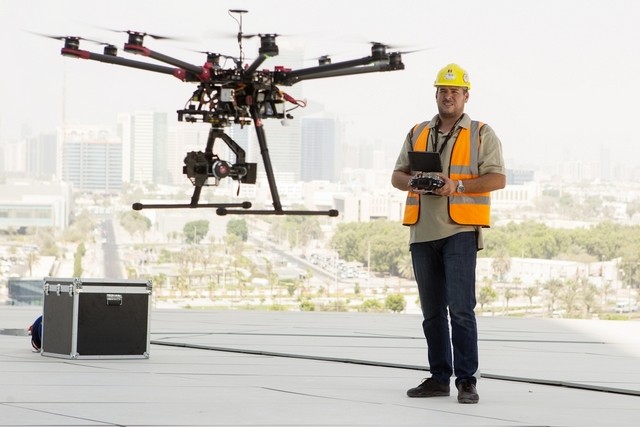
Adriah Ninteoar, the pilot for Technometer Middle East, uses drone technology with an attached thermal camera to inspect and scan the exterior of Etihad Towers in Abu Dhabi for tiny holes where cold air might escape
Abu Dhabi // Property manager Richard Foulds had a problem: there were tiny air leaks in the window seals in Etihad Towers, and using men on ropes to find them was, as he says, “like looking for a needle in a haystack”.
Then, when the makers of the action movie Furious 7 were filming a spectacular car stunt at the skyscrapers on Abu Dhabi’s Corniche, inspiration struck. Mr Foulds had conversations with the film’s production team, who explained some of the drone technology being used in the movie industry.
“We thought, if we could get a camera that could detect cold air, warm air and changes in temperature, get that connected to a drone, and that could fly around, would it be able to spot leaks effectively in the facade?” he said.
The result is that for the next six weeks, tenants in the towers will see a drone flying outside their windows inspecting the buildings.
Staff and tenants had noticed water droplets around some window-sill seals, where warm air was coming in and cold air was escaping.
“It’s a glass monolith, natural light was key for the architects,” said Mr Foulds, head of property management at the towers. “But when you build a development like this at this scale and this magnitude, and in an environment with such harsh conditions, you will get problems.”
Technometer, a Romanian company with offices in Abu Dhabi, had the drone technology to solve Mr Foulds’s problem.
Technometer’s technical team conducted test flights this week and surveyed the five towers, which range from 53 to 77 floors.
“They are doing an electronic map of all of the buildings, so that when they can identify the exact location where the air is coming out, they believe they will be between three to five millimetres of where the hole is. And they will be able to map it digitally,” Mr Foulds said.
A maintenance worker can then descend from the roof to accurately locate and fix the leaks, some which could be as small as a pinprick, he said.
The drone is equipped with GPS and three cameras – thermal, a GoPro to film the entire operation, and a third camera that assists the operator.
With their vast surfaces of heat-radiating glass, the towers can reach an external temperature of 65°C, but where there is a leak the temperature can go down to 40°C.
“There are some gaps between the windows, and this is creating really high costs in air conditioning. The cool air is getting out,” said Cosmin Neacsu, Technometer’s operations manager. The problem, which he said affects many buildings in the region, is compounded when humidity enters, possibly leading to mould.
For Mr Foulds, the potential benefits are massive. In addition to energy savings, estimates for manually surveying the facade have run as high as Dh14 million and could require a year’s work.
If the wind co-operates, he said the drone would need only several weeks and would cost between 10 to 20 per cent of what they would expect to pay for manual work.
Michael Heywood, strategic director for Atkins, a design and engineering consultancy, said developments with drone technology had been far and wide for the property industry.
A particular benefit with the technology used at Etihad Towers was in health and safety, he said, as the drones would undertake work normally carried out by someone suspended hundreds of feet in the air.
“It’s opened up a lot of opportunities, really,” he said.
Andy Gregory, 37, a Canadian expatriate who lives on the 18th floor, has no qualms about a drone buzzing around her apartment window. “The first thing I thought is that it’s really cool technology. It is a good thing, because the towers are so big.”
Photo: Christopher Pike / The National
Source: The National | UAE
